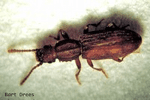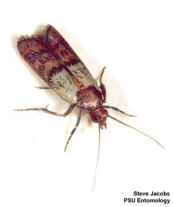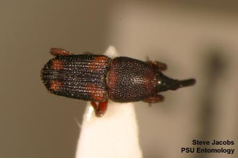Pantry or kitchen pests infest dry or stored food products in the home. Most are either beetles or moths. Infestations occur when these insects are found in some products, but more commonly when the adults are seen crawling or flying about the kitchen or pantry. The insects live and breed best under warm, humid conditions – conditions often found in kitchen cupboards. Reproduction is continuous throughout the year and populations can build rapidly if left undisturbed.
SOURCE OF INFESTATION
Pantry pests are brought into the home in infested food packages and spread to susceptible products.
SUSCEPTIBLE PRODUCTS
Items most likely to be infested with pantry pests include grains, flour, bran, cereal, breakfast foods, dried fruits, nuts, crackers, cookies, matzos, macaroni, spaghetti, candy, chocolate, cocoa, cheese and dried meats. Also they can be found in dry dog and cat food, bird and vegetable seeds, cornstarch, dried soup mixes and other dehydrated foods, and in spices – especially red pepper, paprika and chili powder.
MOST COMMON PANTRY PESTS
The most frequently encountered pantry pests in Connecticut homes are the saw-toothed grain beetle, the Indian meal moth, and the rice weevil.
 The Saw-Toothed Grain Beetle – A small brownish beetle about 1/10-inch long with six tooth-like projections on either side the thorax.
The Saw-Toothed Grain Beetle – A small brownish beetle about 1/10-inch long with six tooth-like projections on either side the thorax.
The Indian Meal Moth – A small insect with a wingspan of about ¾ of an inch. The front wings are a light tannish color on the front third, while the back two thirds are reddish-brown with a coppery luster.
The Rice Weevil – A small, black snout beetle about 1/8-inch long with four reddish or yellowish spots on its back.
LESS COMMON PANTRY PESTS
Other pantry pests include the granary weevil, Angoumois grain moth, bean weevil, and lesser grain borer. These insects are largely internal feeders on whole grain products like the rice weevil and therefore are seldom seen until the adults emerge from the grain.
CONTROL OF PANTRY PESTS
Inspection – Always keep in mind that many pantry pests are strong fliers and that their larvae can crawl some distance from a source of infestation. The source of infestation is limited to a small area such as the kitchen, or a single cabinet, or a single susceptible product. Before you attempt control, find out this source and eliminate it. Check all the materials. Sealed container may be infested because the lid may be loose enough to allow pantry pests to escape from it.
Sterilization – It is possible to kill pantry pests by putting lightly infested packages in the refrigerator freezer compartment for two or three days.
Sanitation – Periodically clean all shelves in storage areas. Many pantry pests can breed in food particles that spill or sift from packages and accumulate in cracks and corners. Buy only small quantities of foods susceptible to infestation. Carefully examine foods when you get them to be sure they are free of pests. Dry foods can be stored in clean glass or metal containers with tight fitting lids. Clean containers thoroughly before placing fresh food in them. Never leave them undisturbed for long periods of time.
Insecticides – Are not recommended for use against pantry pests.
Pheromone Traps – Pheromone traps are only available for Indian meal moths and they just attract male moths.
Prepared by: Milton G. Savos, Extension Entomologist, Revised by D. Pettinelli, UConn Home & Garden Education Center, 2007

